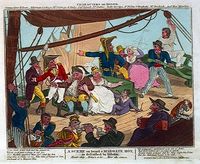Annotation:Margate Hoy (The): Difference between revisions
No edit summary |
No edit summary |
||
| Line 7: | Line 7: | ||
[[File:hoy.jpg|200px|thumb|left|A scene aboard a Margate Hoy, as described by (Charles) Dibdin, 1804]] | [[File:hoy.jpg|200px|thumb|left|A scene aboard a Margate Hoy, as described by (Charles) Dibdin, 1804]] | ||
A 'hoy' was a small sloop-rigged coasting ship or a heavy barge used for freight, usually displacing about 60 tons. The word derives from the Middle Dutch ''hoey''. The multi-purpose hoys were employed by the British navy as workboats, to transport fresh water, gunpowder or ballast, or for laying buoys or survey work. Others escorted coastal convoys and were deployed against smugglers. During the wars with France at the end of the 18th century the Royal Navy armed some Dutch hoys as gun-ships, particularly for service under Admiral Sir Sidney Smith. Concern about a possible French invasion led the Royal Navy in 1804 to arm sixteen hoys at Margate for the defense of the coast [wikipedia]. | A 'hoy' was a small sloop-rigged coasting ship or a heavy barge used for freight, usually displacing about 60 tons. The word derives from the Middle Dutch ''hoey''. The multi-purpose hoys were employed by the British navy as workboats, to transport fresh water, gunpowder or ballast, or for laying buoys or survey work. Others escorted coastal convoys and were deployed against smugglers. During the wars with France at the end of the 18th century the Royal Navy armed some Dutch hoys as gun-ships, particularly for service under Admiral Sir Sidney Smith. Concern about a possible French invasion led the Royal Navy in 1804 to arm sixteen hoys at Margate for the defense of the coast [wikipedia]. | ||
<br> | |||
<br> | <br> | ||
<br> | <br> | ||
Revision as of 02:33, 2 July 2013
Back to Margate Hoy (The)
MARGATE HOY, THE. English, Country Dance Tune (6/8 time). G Major. Standard tuning (fiddle). AABB. The melody was entered into the music manuscript copybook of musician John Fife, a fifer or fiddler who may have been from Perthshire and who made his entries in the last two decades of the 18th century. Fife may also have been to sea, for there are references to battles in the Caribbean and the Mediterranean in his collection.

A 'hoy' was a small sloop-rigged coasting ship or a heavy barge used for freight, usually displacing about 60 tons. The word derives from the Middle Dutch hoey. The multi-purpose hoys were employed by the British navy as workboats, to transport fresh water, gunpowder or ballast, or for laying buoys or survey work. Others escorted coastal convoys and were deployed against smugglers. During the wars with France at the end of the 18th century the Royal Navy armed some Dutch hoys as gun-ships, particularly for service under Admiral Sir Sidney Smith. Concern about a possible French invasion led the Royal Navy in 1804 to arm sixteen hoys at Margate for the defense of the coast [wikipedia].
The hoy, a rather modest, even comical workboat, seemed to inspire Charles Dibdin (1745-1814), who composed a comic song called "The Margate Hoy." It begins:

Standing one summer's day on the Tower Slip,
Careless how I my time should employ,
It popp'd in my head that I'd take a trip
Aboard of a Margate hoy:
I took a few slops, such as shirts and a coat,
For of prog I knew well they'd be stor'd;
Then I hall'd a pair of oars, shov'd off my boat,
And away I dash'd aboard.
See "Annotation:Margate Assembly" for more on the spa town of Margate.
Source for notated version:
Printed sources: Thompson (Compleat Collection of 200 Favourite Country Dances, vol. 5), 1788; No. 122, p. 61.
Recorded sources:
